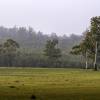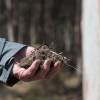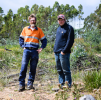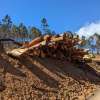
Growing trees, grazing sheep: Hobby farmer’s vision for silvopasture success
Posted 24 March 2025
Plantation Planning Species, sites and planting On-farm benefits Economic benefits and markets Carbon benefits Tree Alliance
A hobby farmer hopes that his unique specialty timber silvopasture project will pave the way for other Tasmanian landowners to adopt the practice with confidence.
Julian Devery plans to plant more than 2000 Castanea sativa—commonly known as sweet chestnut—seedlings at low density on his 21-hectare property at Riana in the state’s North-West for carbon abatement, specialty timber harvest, agricultural, and tourism benefits.
The sweet chestnut plantation will add to the existing 1150 oaks on the property, all of which will be under-grazed by Julian’s flock of 80 premium Wiltipoll cross Aussie White sheep.
Julian was one of three farmers to receive a share of the $450,000 Stems for CO₂ co-investment program, supported by the State Government’s Renewables, Climate and Future Industries Tasmania initiative, and will use the funds to bring his vision to fruition.
Under Stems for CO₂, approximately 250 hectares of commercial trees will be planted across the properties of Julian, Alison Napier, and Dougal Morrison in Riana, St Marys, and Oatlands, respectively.
The Tasmanian Government’s $10 million commitment in 2023 to maintain the state’s net-zero emissions status has been pivotal, with $600,000 allocated to Private Forests Tasmania to co-invest with landowners in establishing plantations for forestry and carbon farming while helping communicate the benefits of growing trees to other farmers and landowners.
“We've had oaks here since about 2013, and in the dry months we notice how much better the grass grows in their shade compared to regular sheep paddocks without shade,” Julian said.
“This opportunity with Private Forests Tasmania came up, and chestnuts were on the list of alternative specialty timber tree species that were compatible with the program, so we did a bit more research.
“Landowners have been growing sweet chestnuts in a silvopasture system since Roman times, specifically with sheep, and it's still widely practised in that part of the world.
“In Switzerland, Italy, and other regions, they still do it successfully, achieving good outputs for both sheep and timber.”
Julian will carry out three separate sweet chestnut plantings with varying stem density ratios per hectare in August 2026, following site preparation, including weed management and browsing control fencing.
The largest planting—10 hectares—along with another 2-hectare planting on a medium incline, will be established at 165 stems per hectare, while a more moderately sloped 2-hectare section will be planted at 35 stems per hectare.
The soil is deep, rich volcanic red and brown, and due to runoff from the hill, much of it remains slightly moist and fertile when surrounding flat land is dry and hard.
Julian’s project will sequester 9,167 tonnes of CO2e* across 25 years on the first rotation. That’s enough to offset annual emissions from 1,993 cars or 524 homes.†
While carbon abatement over a 40-year rotation is not Julian’s primary motivator, he is keen to compare its sequestration potential against more common commercial species in Tasmania, such as radiata pine.
“When we researched chestnut trees, one of the things that stood out was that, unlike pretty much any other tree, once you harvest the timber, they can be coppiced at ground level,” he said.
“You cut them off at the ground, and the tree regrows itself, restarting the whole timber production and carbon capture cycle — without the farmer having to deal with tree stumps or replanting.”
Julian said there are numerous benefits to using a silvopasture farming method, including improved animal welfare, water retention, and business diversification through agritourism.
“There’s not much green grass out in the open paddocks in mid-February heading into March, but amongst the existing oak trees, the grass is still green,” he said.
“The oak plantation already provides superior sheep grazing conditions compared to open paddocks, and this should also apply to the new plantings.
“The two-hectare paddock with a broad-grid ‘dehesa’ planting layout will be compatible with commercial hay baling machinery, which will be of real interest to prospective silvopasture farmers who visit.
“The timber should be valuable at some point — probably for my kids to sell rather than myself in 40 or so years.
“This is also a really beautiful spot in Riana, and we’re planning to put in some tourist farm-stay accommodation.
“Chestnut trees are stunning, and chestnut plantations are picturesque, especially in autumn. People could even get married here.”
Preparations for planting have begun, including weed management, fertiliser application, and browsing and grazing control measures such as tree guards.
Planting will be carried out by spade or using a handheld auger with no additional soil preparation required.
If you are interested in integrating and growing trees on your property, email Private Forests Tasmania at admin@pft.tas.gov.au or call the free helpline on 1300 661 009 for more information.
*CO2e is carbon dioxide equivalent, a measure used to compare the emissions from greenhouse gases across various sources. Figures calculated by Private Forests Tasmania via Esk Mapping.
†Calculated based on average annual passenger vehicle emissions of 4.6 metric tonnes of CO2e and average annual household emissions of 17.5 metric tonnes of CO2e.





